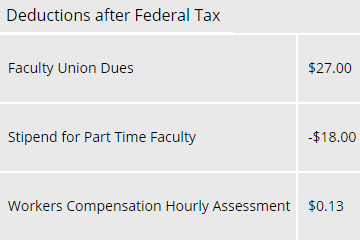Module 2: Negative Numbers
Negative numbers are a fact of life, from winter temperatures to our bank accounts. Let’s practice evaluating expressions involving negative numbers.

Absolute Value
The absolute value of a number is its distance from ![]() . You can think of it as the size of a number without identifying it as positive or negative. Numbers with the same absolute value but different signs, such as
. You can think of it as the size of a number without identifying it as positive or negative. Numbers with the same absolute value but different signs, such as ![]() and
and ![]() , are called opposites. The absolute value of
, are called opposites. The absolute value of ![]() is
is ![]() , and the absolute value of
, and the absolute value of ![]() is also
is also ![]() .
.
We use a pair of straight vertical bars to indicate absolute value; for example,![]() and
and ![]() .
.
Exercises
Evaluate each expression.
1. ![]()
2. ![]()
Adding Negative Numbers
Exercises
Perform each addition.
3. ![]()
4. ![]()
Exercises
Perform each addition.
5. ![]()
6. ![]()
7. ![]()
8. ![]()
9. The temperature at noon on a chilly Monday was ![]() °F. By the next day at noon, the temperature had risen
°F. By the next day at noon, the temperature had risen ![]() °F. What was the temperature at noon on Tuesday?
°F. What was the temperature at noon on Tuesday?
If an expression consists of only additions, we can break the rules for order of operations and add the numbers in whatever order we choose.
Exercises
Evaluate each expression using any shortcuts that you notice.
10. ![]()
11. ![]()
Subtracting Negative Numbers

Exercises
Perform each subtraction.
12. ![]()
13. ![]()
14. ![]()
15. ![]()
16. ![]()
17. ![]()
18. ![]()
19. ![]()
20. One day in February, the temperature in Portland, Oregon is ![]() °F, and the temperature in Portland, Maine is
°F, and the temperature in Portland, Maine is ![]() °F. What is the difference in temperature?
°F. What is the difference in temperature?
Multiplying Negative Numbers

Suppose you spend ![]() dollars on a coffee every day. We could represent spending 3 dollars as a negative number,
dollars on a coffee every day. We could represent spending 3 dollars as a negative number, ![]() dollars. Over the course of a
dollars. Over the course of a ![]() -day work week, you would spend
-day work week, you would spend ![]() dollars, which we could represent as
dollars, which we could represent as ![]() dollars. This shows that
dollars. This shows that ![]() , or
, or ![]() .
.
If two numbers with opposite signs are multiplied, the product is negative.
Exercises
Find each product.
21. ![]()
22. ![]()
Going back to our coffee example, we saw that ![]() . Therefore, the opposite of
. Therefore, the opposite of ![]() must be positive
must be positive ![]() . Because
. Because ![]() is the opposite of
is the opposite of ![]() , this implies that
, this implies that ![]() .
.
If two numbers with the same sign are multiplied, the product is positive.
WARNING! These rules are different from the rules for addition; be careful not to mix them up.
Exercises
Find each product.
23. ![]()
24. ![]()
Recall that an exponent represents a repeated multiplication. Let’s see what happens when we raise a negative number to an exponent.
Exercises
Evaluate each expression.
25. ![]()
26. ![]()
27. ![]()
28. ![]()
If a negative number is raised to an even power, the result is positive.
Dividing Negative Numbers
Let’s go back to the coffee example we saw earlier: ![]() . We can rewrite this fact using division and see that
. We can rewrite this fact using division and see that ![]() ; a negative divided by a positive gives a negative result. Also,
; a negative divided by a positive gives a negative result. Also, ![]() ; a negative divided by a negative gives a positive result. This means that the rules for division work exactly like the rules for multiplication.
; a negative divided by a negative gives a positive result. This means that the rules for division work exactly like the rules for multiplication.
If two numbers with opposite signs are divided, the quotient is negative.
If two numbers with the same sign are divided, the quotient is positive.
Exercises
Find each quotient.
29. ![]()
30. ![]()
31. ![]()
32. ![]()
33. ![]()
34. ![]()
Go ahead and check those last three exercises with a calculator. Any surprises?
0 divided by another number is 0.
A number divided by 0 is undefined, or not a real number.
Here’s a quick explanation of why ![]() can’t be a real number. Suppose that there is a mystery number, which we’ll call
can’t be a real number. Suppose that there is a mystery number, which we’ll call ![]() , such that
, such that ![]() . Then we can rewrite this division as a related multiplication,
. Then we can rewrite this division as a related multiplication, ![]() . But because
. But because ![]() times any number is
times any number is ![]() , the left side of this equation is
, the left side of this equation is ![]() , and we get the result that
, and we get the result that ![]() , which doesn’t make sense. Therefore, there is no such number
, which doesn’t make sense. Therefore, there is no such number ![]() , and
, and ![]() cannot be a real number.
cannot be a real number.
Order of Operations with Negative Numbers
P: Work inside of parentheses or grouping symbols, following the order PEMDAS as necessary.
E: Evaluate exponents.
MD: Perform multiplications and divisions from left to right.
AS: Perform additions and subtractions from left to right.
Let’s finish up this module with some order of operations practice.
Exercises
Evaluate each expression using the order of operations.
35. ![]()
36. ![]()
37. ![]()
38. ![]()
39. ![]()
40. ![]()

